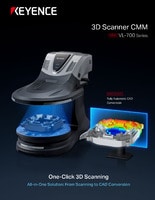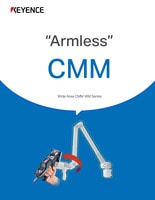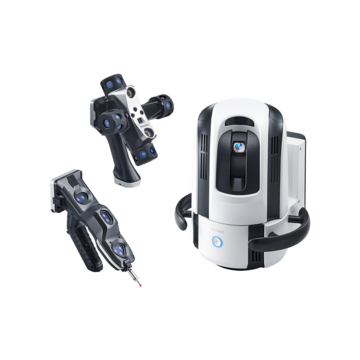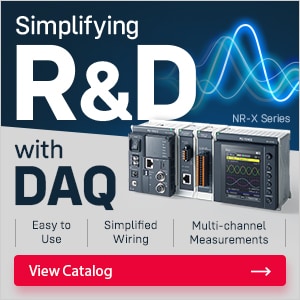CMM (Coordinate Measuring Machine)
How to Choose the Right Handheld 3D Scanner for Your Applications
In today’s fast-evolving world of 3D technology, choosing the right handheld 3D scanner for your applications can make a significant difference in the efficiency and quality of your work. Whether you work in manufacturing, product design, or quality inspection, finding the right balance between accuracy, portability, ease of use, and cost is crucial. As the market expands, handheld scanners are becoming more versatile, so understanding what to look for is essential. In this guide, we’ll explore the key factors to consider, focusing on accuracy, portability, software compatibility, and pricing.
We’re here to provide you with more details.
Reach out today!

Choosing a 3D Scanner Based on Accuracy
The level of detail you need depends on the type of work you're doing. For industries such as automotive, aerospace, and medical devices, precision is vital, so having a scanner with high accuracy is essential, whereas high-accuracy scanners for prototyping or reverse engineering applications might not be necessary due to the nature of the application.
- A portable 3D scanner is ideal for capturing objects in the field or in various other locations. These scanners balance portability with precision, often ranging from 0.1 mm to 0.05 mm in accuracy, which is adequate for most general-purpose applications.
- A 3D scanner combined with a touch-based CMM can help meet tight tolerances for specific dimensions that the scanner itself might not be able to pick up so accurately. These can be a powerful tool if both shape and accurate dimensional data are crucial to your process.
Key Consideration: If your work requires extremely precise measurements, choose a high-accuracy handheld 3D scanner, or look towards a CMM/scanner combo to meet tight tolerances for specific dimensions.
Choosing a 3D Scanner Based on Portability and Size
Portability is a major consideration when choosing a handheld 3D scanner, especially if you need to scan objects in different locations or hard-to-reach areas.
Some handheld 3D scanners are compact and easy to use, making them ideal for capturing all necessary 3D data, regardless of location. These models are ergonomically designed, lightweight, and capable of scanning in tight or awkward spaces, allowing them to be used outside of lab settings.
The other of the two major portable 3D scanner types are scanner arms. The scanner arms usually work in conjunction with a CMM probe and can be a bit cumbersome to move around due to the nature of the arm they are attached to, while the aforementioned scanner probes can be moved freely around their designated scanning range.
Key Consideration: If the data you are gathering is outside of a lab setting or located in various possible locations, look for a more portable scanning option such as a probe scanner to make moving the equipment easier and faster.
Choosing a 3D Scanner Based on Ease of Use and Software Compatibility
Ease of use is an important factor, particularly for teams that may not have a deep technical background. The simpler the scanner is to operate, the faster your team can become productive.
In an environment where there may not be an expert on 3D software, or individuals on the team are familiar with other types of 3D software that are tough to use, it’s imperative to find a handheld 3D scanner that’s intuitive and user-friendly. Many come with software that simplifies the process of capturing and editing 3D models, but they need to utilize a third-party software to clean up the data to create a final model, which could take over a day to finalize. It’s best to look for scanners that offer software which integrates all measurement data along with scan data in one place.
Key Consideration: If ease of use and quick implementation are important to you, especially for team-wide adoption, a handheld 3D scanner with intuitive software is recommended.
Choosing a 3D Scanner Based on Price
Price is always a factor when investing in new technology. Handheld 3D scanners can range widely in cost, depending on their features and capabilities (anywhere from a couple thousand, to hundreds of thousands of dollars). When determining the 3D scanner most appropriate for you, make sure to consider the key features that are necessary for your applications, and find a scanner that can meet your needs.
Key Consideration: A handheld 3D scanner offers a good balance of performance and price. If you’re working within a tighter budget but still need a capable scanner, these tools can offer an affordable solution.
Curious about our pricing?
Click here to find out more.
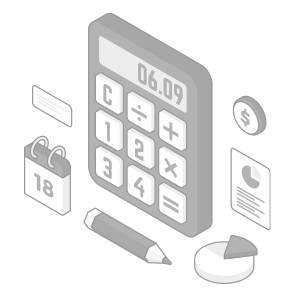
Finding the Right Handheld 3D Scanner for Your Needs
When selecting a handheld 3D scanner, the most important factors are accuracy, portability, ease of use, and budget. With so many different technologies available, it’s important to understand where each option falls on these respective scales.
By assessing your specific application requirements, whether it's for scanning small, detailed objects or larger industrial items—you can make an informed decision that maximizes the value of your investment in 3D scanning technology.
We’re here to provide you with more details.
Reach out today!

Let KEYENCE Help With Your Portable 3D Scanner Search
The KEYENCE WM-6000 Handheld 3D Laser Scanner and CMM was built to be a one-stop solution for large part inspection.
Accuracy: With an up to 82 ft measuring range, the WM-6000 boasts fantastic accuracy over the scanning area and includes a touch probe for high precision dimensional measurement.
Portability: The WM-6000 handheld scanner probe works in conjunction with a light-weight camera head unit to track the probe as it moves in the measurement area. This set-up allows the system to go wherever necessary, so you can scan whatever is needed. The software can also be used directly from the handheld probe, allowing for unrestricted movement throughout the measurement process, without the need to walk back and forth from a computer.
Ease-of-Use: The WM-6000 has its own proprietary software that can import CAD models for a CAD overlay, or export for easy reverse engineering. With free training included, anyone can learn to become a user, and the software can create a cleaned model seconds after the part has been scanned.
Price: KEYENCE offers the WM-6000 in 4 different models at 4 different price points, allowing you to purchase the capabilities necessary for your applications and stay in the price range necessary.
You can learn more about the WM-6000 here.
Get detailed information on our products by downloading our catalog.
View Catalog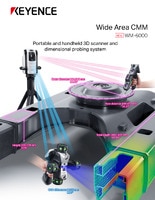

Related Downloads

Brochure for the WM Series Wide-Area CMM. A portable setup with a wireless handheld probe that enables users measure large parts and equipment.

